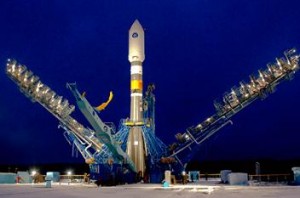Russia launches new generation Navigation Satellite
Russia launches new generation of Navigation Satellite :

A Russian Soyuz 2-1B has launched GLONASS K-1 Global Navigation satellite from the Plesetsk Cosmodrome . Launch from a chilly Pad 43/4 occurred at 21:52 UTC on Sunday.
Check the video of soyuz 2-1B lofts GLONASS K-1 satellite
GLONASS K-1 Launch:
The Russian GLONASS Global Navigation Satellite System – operated by the Russian Aerospace Defence Forces – is currently the only global alternative to the American GPS fleet in operation that has global coverage of comparable precision.
Europe is currently working towards its Galileo system, while other countries are building their own GPS systems – such as the Chinese BeiDou Navigation Satellite constellation.
Development of GLONASS began in the Soviet Union in 1976. By the turn of the this decade, GLONASS had achieved 100 percent coverage, with the full orbital constellation of 24 satellites operational in 2011.
The Russians are continually launching GLONASS satellites, with varying success. One of the biggest failures came when three GLONASS-M birds were lost when their Proton-M launch vehicle dramatically failed during launch.
GLONASS-K is the latest version of the satellite design. Developed by Reshetnev Information Satellite Systems, the first satellite in this range was launched on 26 February, 2011. This latest satellite was set to launch the following year, ahead of several major delays.
The K Series are an advanced improvement of the previous M second-generation satellites, with longer lifespans and better accuracy.
 The Soyuz-2 is the latest in a long line of Russian rockets derived from the R-7 missile, which became the world’s first intercontinental ballistic missile when it flew in 1957.
The Soyuz-2 is the latest in a long line of Russian rockets derived from the R-7 missile, which became the world’s first intercontinental ballistic missile when it flew in 1957.
The Soyuz is descended from the Voskhod rocket, an R-7 derivative which was developed to launch the Soviet Union’s second-generation manned spacecraft and reconnaissance satellites. Soyuz incorporated the Blok-I third stage originally developed for the Molniya rocket, but lacked the Molniya’s fourth stage.
The Soyuz-2 is a more complete modernisation, and will eventually replace the Soyuz-U and FG.
 Compared to the Soyuz-U, the Soyuz-2 has modernised first and second stage engines – the RD-107A and RD-108A respectively, which were introduced on the Soyuz-FG. It also includes modifications to the third stage, and a digital flight control system, features not present on the Soyuz-FG.
Compared to the Soyuz-U, the Soyuz-2 has modernised first and second stage engines – the RD-107A and RD-108A respectively, which were introduced on the Soyuz-FG. It also includes modifications to the third stage, and a digital flight control system, features not present on the Soyuz-FG.
The third stage of the Soyuz-2-1A retains the RD-0110 engine used on previous variants, while the Soyuz-2-1B is propelled by an RD-0124.
A third Soyuz-2 variant, the Soyuz-2-1V, differs significantly from the rest of the R-7 family, consisting of only the second and third stages of the Soyuz-2-1B, without the first stage, and with an optional Volga upper stage.
 For the 2-1V, the first stage (the 2-1B’s second stage) is powered by an NK-33 engine with an RD-0110R vernier. The 2-1v’s debut occurred at the end of 2013. Exclusive documentation on this vehicle was acquired by L2 (LINK).
For the 2-1V, the first stage (the 2-1B’s second stage) is powered by an NK-33 engine with an RD-0110R vernier. The 2-1v’s debut occurred at the end of 2013. Exclusive documentation on this vehicle was acquired by L2 (LINK).
The Soyuz-2-1B is a three-stage rocket by the numbering system used by Russia. Under the system more commonly used in the west, it would be regarded a two-stage rocket, with four strap-on boosters, however instead the strap-ons are numbered stage 1, the first core stage is numbered stage 2, and the second core stage is numbered stage 3.
The first and second stage engines ignited together, about 17 seconds ahead of launch, building up to full thrust before the four swing-arms holding the rocket down was released.
Following liftoff, the rocket flew for approximately 118 seconds before the first stage separated. The four strap-ons fell away from the rocket and back towards Earth, forming a pattern known as the Korolev Cross after Sergei Korolev, the designer of the R-7.
The second stage continued to burn for another 170 seconds, before separating from the third stage. The Upper Stage was then Fregate, providing the final thrust to place the satellite into it required orbit.
These missions usually launch from the Baikonur Cosmodrome.
Sites 16/2 and 43/4 at Plesetsk were originally not able to host the Soyuz 2. However, they have since been converted.
Apply for Home Loans HERE



